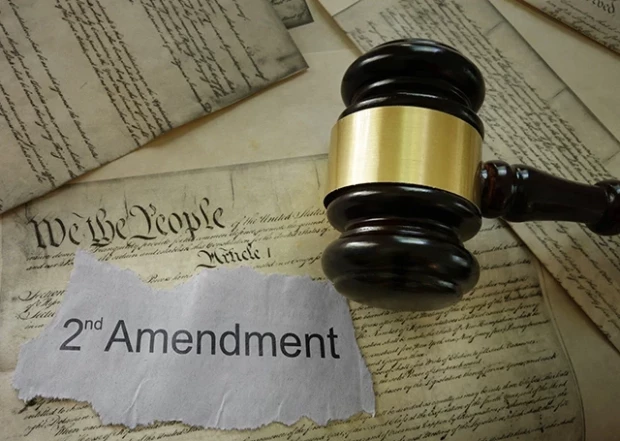Search
Cart
There are no items in your cart.
Login
The Second Amendment: Safeguarding Liberty in a Changing World

The Second Amendment to the United States Constitution, enshrined in the Bill of Rights, has been a focal point of rigorous debate, varied interpretation, and a source of national discourse since its ratification in 1791. This amendment, succinct yet profound in its implications, reads: "A well regulated Militia, being necessary to the security of a free State, the right of the people to keep and bear Arms, shall not be infringed."
This carefully chosen phrasing, resounding from the era of the Founding Fathers, has been dissected and scrutinized over centuries, stirring a multitude of interpretations and provoking intense dialogue regarding its contemporary relevance and application. The phrase "well regulated Militia" has been of particular interest, sparking innumerable discussions and court cases dissecting its meaning and the implications it carries for an individual's right to own and carry weapons in the fast-paced, ever-evolving milieu of the 21st century.
The influence of the Second Amendment on American society extends far beyond its impact on firearm ownership. It has shaped legal precedent, influenced cultural attitudes, and defined aspects of American identity. As we delve into the complexities of the Second Amendment, it's crucial to understand its historical context, analyze its evolution over time, and grapple with the challenging questions it poses to us today. Amid shifting societal landscapes and evolving technology, how do we interpret and apply this centuries-old constitutional right in a manner that safeguards individual liberties while promoting public safety? This exploration aims to provide insight into these pressing questions.
.
Historical Context
The Second Amendment can only be fully appreciated when viewed through the lens of its historical context. The late 18th century marked a period of profound political and social change, with the United States of America striving to establish its identity in the aftermath of a hard-fought revolution.
This era was characterized by a deep-seated mistrust of centralized power, a sentiment born out of the bitter experiences of British rule. The framers of the Constitution, living through this transformative time, were deeply influenced by these experiences and held strong views on governance and the preservation of individual rights.
Prominent among these framers were George Mason and Patrick Henry, both from Virginia. Initially, James Madison, a principal drafter of the Constitution, did not see the need for a Bill of Rights, as he believed the Constitution already adequately outlined the powers and limitations of the new government. However, Mason and Henry, distrusting the potential for future governments to disregard the Constitution's limits, insisted on the inclusion of a Bill of Rights. They argued that such an explicit declaration of rights was necessary to safeguard individual liberties against potential governmental overreach. Their adamant stance prevailed, leading to the creation and inclusion of the Bill of Rights, of which the Second Amendment is a part.
A key component of the framers' vision for the new nation was citizen militias, which played a crucial role in the defense of the nascent country. In the absence of a large, centralized standing army, local militias, composed of ordinary citizens supplying their own weapons, served as the primary defensive force. This experience of self-defense and resistance during the Revolutionary War deeply influenced the framers' conception of a "well-regulated militia."
In the parlance of the 18th century, "well regulated" meant something akin to "well functioning" or "in good order". This term referred to a group of citizens who were effectively equipped, disciplined, and ready to function as a coordinated defensive force, capable of responding to threats both foreign and domestic.
As a testament to this, George Mason argued that a "well-regulated militia, composed of the Gentlemen, Freeholders, and other Freemen was the natural strength and only security of a free Government." This statement encapsulates the belief that an armed citizenry could act as a safeguard against potential government overreach, thus balancing power in a free society.
In essence, the Second Amendment, rooted in the historical context of its time, serves a dual purpose. It not merely provides for the defense of the country, but also embodies a critical component of the framers' vision for a free, balanced society where power remains in the hands of the people. This understanding is vital for any modern discussion or interpretation of the Second Amendment's relevance and application.
.
Modern Interpretation
As we journey into the 21st century, the landscape of national defense has drastically transformed. The United States now hosts a formidable standing military and an intricate network of law enforcement agencies at local, state, and federal levels. Alongside these changes, the notion of the citizen militia has evolved, though it remains preserved in U.S. law, taking on both organized and unorganized forms.
The organized militias of today, represented by institutions like the National Guard and the Naval Militia, are rigorously regulated bodies. They undergo formal training programs, adhere to strict regulations, and receive substantial government funding. These forces are on standby, prepared to respond to domestic crises, natural disasters, and, under specific circumstances, can supplement the U.S. military in international engagements.
In contrast, the concept of the unorganized militia lives on in a less structured form. The Militia Act of 1903 defines this group as all able-bodied citizens or intended citizens, not members of the National Guard or Naval Militia, aged between 17 and 45. Despite the practical considerations that likely influenced this age range, the unorganized militia lacks the formal training, structure, and regulation of its organized counterparts, raising questions about its modern relevance and efficacy.
The evolution of the "militia" concept and its relevance in the 21st century sparks ongoing legal, political, and academic debates, often with the Second Amendment at the heart of these discussions. These debates center around two primary interpretations: the "collective rights theory" and the "individual rights theory".
Those who endorse the collective rights theory posit that the Second Amendment only protects the right to bear arms in the context of a well-regulated militia. They argue that the original intent of the amendment was to prevent the federal government from disarming state militias, not to guarantee an individual's right to own firearms.
Contrarily, proponents of the individual rights theory argue that "the right of the people to keep and bear Arms" is a personal right, independent of any militia service. They argue that the Second Amendment guarantees an individual's right to own firearms for self-defense, hunting, sport, and other lawful purposes.
The Supreme Court case District of Columbia v. Heller in 2008 marked a significant turning point in this debate, affirming the individual rights theory. The ruling acknowledged an individual's right to possess a firearm, unconnected with service in a militia, and to use that arm for traditionally lawful purposes such as self-defense within the home. However, the ruling does not exclude the right to self-defense in other contexts, although further legal refinements are necessary to clarify this right's full extent. This landmark case heralded a significant shift in Second Amendment jurisprudence, and its influence continues to shape the ongoing dialogue surrounding the right to bear arms in the United States.
.
The Evolution of Firearms and the Core Principles of the Second Amendment
The technological advancements in firearms since the inception of the Second Amendment have been significant. The single-shot muskets available during the 18th century have evolved into the more efficient semi-automatic firearms of today. Critics of the modern application of the Second Amendment often use this evolution to question the amendment's relevance, arguing that the framers could not have possibly anticipated the rapid technological advancements in firearms.
However, this perspective arguably overlooks the core principles embedded in the Constitution and the Bill of Rights. These principles were intended to be timeless, addressing fundamental human rights and the balance of power between the individual and the state. Just as the First Amendment's protection of free speech adapts to modern forms of communication such as the internet and social media, the Second Amendment's protection of the right to bear arms applies to the firearms of today.
A contentious term in today's discourse on firearms is "assault weapon," often used to describe certain semi-automatic firearms. Critics argue that this term is politicized and misleading, incorrectly applied to semi-automatic firearms based on aesthetic features rather than functional characteristics. The term "assault," they argue, refers to an act committed by a person, not a characteristic of a tool.
In this context, the campaign against so-called "assault weapons" is seen as an attempt to gradually limit, and potentially eliminate, the rights protected by the Second Amendment. The challenge lies in defending the rights of individuals to use firearms for legitimate purposes, such as self-defense and sport, while also addressing concerns about firearm misuse. It's crucial to understand that the potential misuse of a tool does not negate its legitimate uses. The right to self-defense, a fundamental principle protected by the Second Amendment, remains as relevant today as it was in the 18th century.
.
The Second Amendment as a Safeguard against Tyranny
The Second Amendment's role as a safeguard against tyranny is deeply rooted in historical experiences and serves as a powerful reminder of the potential dangers of unchecked government power. Numerous examples from history illustrate the importance of an armed citizenry in preserving freedom and resisting oppressive regimes.
For instance, the rise of Nazi Germany and the Bolshevik government in Russia are stark reminders of the consequences when citizens are disarmed and left defenseless against tyranny. In both cases, the first initiatives of these authoritarian regimes were to disarm the population, ensuring no adequate resistance to their oppressive rule. By disarming the citizens, these regimes sought to solidify their control and suppress any opposition or dissent. The tragic outcomes of these periods in history serve as harrowing reminders of the importance of an armed citizenry as a safeguard against encroachments on individual rights and the erosion of democracy.
The Founding Fathers recognized that an armed citizenry serves as a crucial check and balance on the potential abuses of authority. By providing citizens with the means to defend themselves and their liberties, the Second Amendment serves as a tangible reminder to the government that its power is derived from the people and that it has a duty to serve their interests.
The principle of the Second Amendment reflects the broader ethos of the Constitution, which places power in the hands of the people. It reinforces the idea that the ultimate authority resides with the citizenry, and the government is obligated to respect and protect their rights. This understanding is vital as it shapes the interpretation and implementation of the right to bear arms in modern society, emphasizing the importance of maintaining a well-armed populace capable of defending against potential encroachments on their freedoms.
As debates continue regarding the Second Amendment, it is crucial to remember its historical context and the lessons learned from the past. The right to bear arms is not merely an abstract concept but a tangible safeguard against the potential erosion of individual liberties and the rise of tyranny. It stands as a testament to the wisdom and foresight of the Founding Fathers in recognizing the enduring need for an armed citizenry to maintain the delicate balance between government power and individual rights.
.
The Role of Police and the Need for Personal Defense
While discussions on the Second Amendment often revolve around the rights of individuals and collective defense, a critical yet often overlooked aspect is the role of law enforcement and its implications on personal defense. This consideration is particularly relevant in a modern context where the police are the primary providers of public safety.
Despite the substantial role that police departments play in maintaining law and order, it is crucial to understand their constitutional obligations—or the lack thereof—to protect individual citizens. While many assume that law enforcement agencies bear a duty to protect each individual, legal precedents suggest otherwise. The police are generally tasked with the maintenance of public order and the enforcement of laws. Still, they do not bear a constitutional duty to protect every individual from harm.
This principle is not merely theoretical; it has been upheld in various court cases. For instance, in Warren v. District of Columbia (1981), the court ruled that "the fundamental principle of American law is that a government and its agents are under no general duty to provide public services, such as police protection, to any particular individual citizen."
Moreover, even when law enforcement agencies are committed to the safety of citizens, the physical reality of response times means that their protection can't be instantaneous. In emergency situations where threats are imminent, the time it takes for the police to respond—even under optimal conditions—can be the difference between life and death. According to the Bureau of Justice Statistics, the average police response time to an emergency call is about 10 minutes. However, this can significantly increase depending on factors such as the location, the availability of officers, and the nature of the call.
Therefore, the right to self-defense, including the right to bear arms, becomes essential. It is a tangible means for individuals to protect themselves when law enforcement cannot arrive in time or is not obligated to provide immediate protection. This responsibility for personal safety underscores the value of an individual's right to own and operate firearms effectively.
In addition, the presence of firearms can act as a deterrent, discouraging potential aggressors who are aware that potential victims might be armed. This deterrent effect can complement law enforcement efforts, contributing to overall public safety.
Understanding these aspects elucidates why the Second Amendment and the right to bear arms remain relevant today. The concept extends beyond historical militias and touches on the practical realities of self-defense and personal safety in a world where law enforcement cannot always provide immediate protection.
.
Conclusion
The phrase "well regulated militia" in the context of the Second Amendment, the evolution of firearms, and the role of the Amendment as a safeguard against tyranny, have significantly shaped the modern interpretation of the right to bear arms. The right extends as an individual right, with its scope and limitations continuing to be refined in our ongoing quest to harmonize individual rights with public safety.
It is important to acknowledge that individual rights and public safety are not inherently contradictory. In an ideal scenario, the exercise of individual rights, including the right to bear arms, would align perfectly with the broader goals of public safety. However, crafting policies that reflect this ideal balance can be challenging, especially given the complexities of modern society.
Political biases, differing interpretations of the Constitution, and societal changes can all impact this balance. Yet, it is crucial to strive for a world in which the exercise of individual rights enhances, rather than compromises, public safety. To achieve this, we must foster open, honest dialogue, remove political malice, and work towards thoughtful, evidence-based policies that uphold both these essential aspects of our society.
The Second Amendment, with its historical roots and modern implications, exemplifies this ongoing struggle to find a balance. As our society evolves, so too will our understanding and application of this fundamental right, always striving to uphold the principles of liberty and safety that lie at the heart of the American Constitution.
(by Edward Meyman)
NEWSLETTER










Leave a Comment